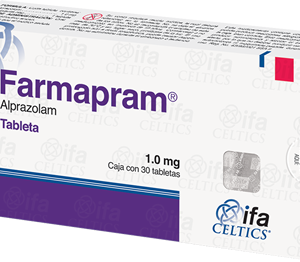- Discount up to 35% for first purchase only this month.
- sales@psychedelicsjourney.com
- +1 (737) 310-1213
What is Farmapram Alprazolam?
Farmapram is a brand name for the medication Alprazolam, a widely prescribed benzodiazepine used primarily to treat anxiety disorders and panic disorders. It works by influencing the central nervous system, providing relief from excessive worry, nervous tension, and panic attacks. As a short-acting anxiolytic, Farmapram is often favored for its effectiveness in managing acute symptoms of anxiety.
1. Anxiolytic Medication
2. Alprazolam Tablet
3. Anti-anxiety Drug
4. Benzodiazepine
5. Panic Disorder Treatment
6. Sedative Effect
7. Farmapram Dosage
8. Alprazolam 0.25mg, 0.5mg, 1mg
9. Short-Term Anxiety Relief
10. Alprazolam Side Effects
11. Farmapram Anxiety Relief
12. Xanax Alternative
13. Calming Medication
14. Alprazolam Generic Brand
15. Mental Health Medication
16. Alprazolam for Panic Attacks
17. Farmapram Medication Uses
18. Benzodiazepine Withdrawal
19. Prescription Anxiety Treatment
20. Stress Relief Drug
21. Alprazolam Mechanism of Action
22. Farmapram Sedation
23. Central Nervous System Depressant
24. Farmapram Safety Profile
25. Alprazolam Half-Life
How Does Farmapram Work?
Farmapram (Alprazolam) functions by enhancing the effects of a neurotransmitter called gamma-aminobutyric acid (GABA) in the brain. GABA acts as a natural calming agent, inhibiting neuronal activity and promoting relaxation. By boosting GABA’s activity, Farmapram helps to reduce anxiety, induce calmness, and produce a sedative effect. This mechanism also accounts for its ability to alleviate symptoms of panic attacks, generalized anxiety disorder (GAD), and social anxiety disorder.
Therapeutic Uses of Farmapram
1. Generalized Anxiety Disorder (GAD)
Farmapram is often prescribed for individuals who experience persistent and excessive worry that interferes with daily life. It provides rapid relief from the physical and emotional symptoms associated with anxiety, such as restlessness, irritability, and muscle tension.
2. Panic Disorder
The medication is highly effective in treating panic attacks, which are sudden episodes of intense fear or discomfort. These attacks are often accompanied by symptoms like sweating, chest pain, palpitations, and difficulty breathing. Farmapram helps in reducing the frequency and intensity of these episodes.
3. Short-Term Management of Anxiety
In some cases, Farmapram is used for short-term management of anxiety, especially in situations where immediate relief is needed, such as in stressful events or situations that provoke extreme anxiety.
Dosage and Administration
Farmapram is typically available in tablet form with varying dosages, including 0.25 mg, 0.5 mg, and 1 mg. The dosage will depend on the condition being treated, the patient’s medical history, and their response to the medication. Generally, lower doses are prescribed initially to assess tolerance, with potential adjustments made based on the patient’s needs.
– Generalized Anxiety Disorder: Typically, 0.25 to 0.5 mg 2 to 3 times a day.
– Panic Disorder: Higher doses may be required, with a typical starting dose of 0.5 to 1 mg, and an increased dose over time.
It’s important to follow the prescribed dosage and avoid exceeding the recommended amount to minimize the risk of side effects or dependence.
Potential Side Effects
While Farmapram is effective, it may cause certain side effects, including but not limited to:
– Drowsiness
– Dizziness
– Dry mouth
– Fatigue
– Memory problems
– Mood changes (e.g., irritability, depression)
Long-term use or overuse can lead to the development of tolerance (requiring higher doses for the same effect) and dependence. Withdrawal symptoms such as anxiety, insomnia, and tremors may occur if the medication is suddenly discontinued.
Precautions and Warnings
– Drug Interactions: Farmapram may interact with other medications, especially those affecting the central nervous system, such as opioids, antidepressants, or alcohol. Combining these substances can increase the risk of sedation, respiratory depression, and overdose.
– Pregnancy and Breastfeeding: Alprazolam is classified as a Category D drug for pregnancy, meaning it could harm an unborn baby. It is advised that Farmapram be used only if the benefits outweigh the potential risks. It should also be avoided during breastfeeding.
– Alcohol Use: Consuming alcohol while on Farmapram can intensify its sedative effects and increase the risk of dangerous side effects.
Alternatives to Farmapram
While Farmapram (Alprazolam) is a popular treatment for anxiety, there are other medications in the benzodiazepine class that may be used, such as Lorazepam and Clonazepam. For those seeking non-benzodiazepine options, medications like SSRIs (Selective Serotonin Reuptake Inhibitors), such as Sertraline and Escitalopram, may be recommended for long-term management of anxiety disorders.
Conclusion
Farmapram (Alprazolam) remains a vital tool in the management of acute anxiety and panic disorders. When used as prescribed and under a healthcare professional’s supervision, it can provide significant relief from symptoms that can be debilitating for many individuals. However, it’s essential to weigh the benefits and risks, particularly regarding long-term use, to ensure the best outcome for those seeking help with anxiety-related issues. Always consult with a doctor or mental health professional before starting or adjusting medication.
| Quantity | 30 Tablets, 60 Tablets, 90 Tablets |
|---|






Psychedelic Journey is a Fast, Friendly, Discrete, Reliable online psychedelic store created to make ordering and mailing products very safe and secure.
Reviews
There are no reviews yet.